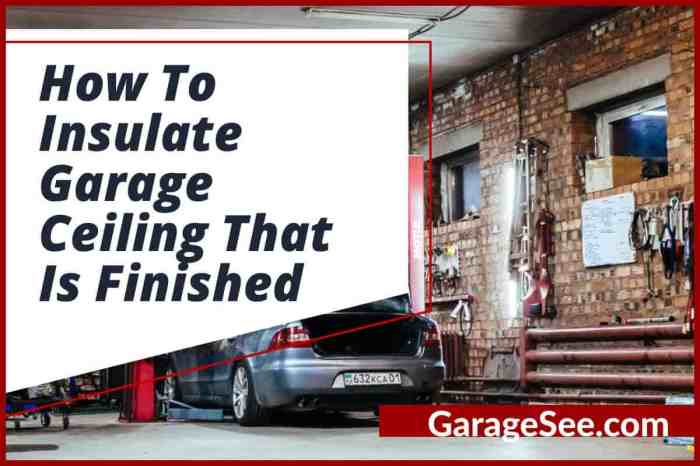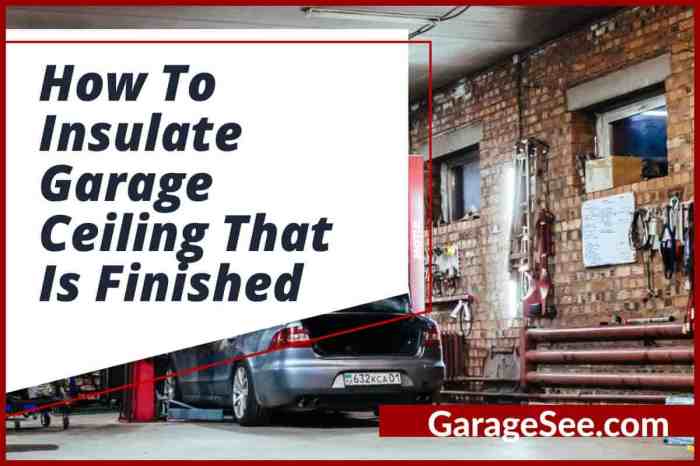DIY garage insulation takes center stage, offering a practical and cost-effective way to enhance your home’s comfort and energy efficiency. This guide provides a comprehensive roadmap for insulating your garage, covering everything from planning and preparation to installation techniques and safety considerations.
From understanding the benefits of insulation to choosing the right materials and methods, this guide empowers you to tackle this project with confidence. Whether you’re seeking to create a more comfortable workspace, protect your belongings from extreme temperatures, or simply reduce your energy bills, insulating your garage is a worthwhile investment.
Planning and Preparation
Proper planning and preparation are crucial for a successful garage insulation project. Before you start installing insulation, take the time to understand your garage’s structure, identify areas that need insulation, and gather the necessary materials.
Preparing the Garage
Before you can start insulating your garage, you need to prepare the space. This includes cleaning, removing obstacles, and sealing any air leaks.
- Clean the garage thoroughly: Remove any clutter, debris, and cobwebs. Sweep or vacuum the floor and walls to remove dust and dirt.
- Remove obstacles: Move any furniture, tools, or other items that might be in the way of the insulation installation.
- Seal air leaks: Air leaks can significantly reduce the effectiveness of your insulation. Inspect your garage for cracks, gaps, and openings around windows, doors, and utility pipes. Seal these leaks with caulk, weatherstripping, or expanding foam.
Understanding Your Garage’s Structure
Before you start insulating, it’s important to understand the structure of your garage. This will help you determine the best type of insulation to use and the best way to install it.
- Identify the framing: Determine the type of framing used in your garage. Common framing types include wood framing, steel framing, and concrete block walls.
- Check for existing insulation: If your garage already has insulation, assess its condition and determine if it needs to be replaced or supplemented.
- Consider the garage’s purpose: If you plan to use your garage as a workshop or living space, you’ll need to install more insulation than if you’re only using it for storage.
Calculating Insulation Needs
The amount of insulation you need will depend on your garage’s dimensions and the local climate.
- Measure the garage’s dimensions: Determine the length, width, and height of your garage. You’ll need this information to calculate the area of each wall and the ceiling.
- Consider the climate: The amount of insulation you need will vary depending on the climate you live in. In colder climates, you’ll need more insulation than in warmer climates.
- Consult local building codes: Check with your local building department for any specific insulation requirements in your area.
To calculate the amount of insulation you need, you can use the following formula:
Area of the surface to be insulated x Recommended R-value = Amount of insulation needed
Insulation Materials Comparison

Choosing the right insulation material for your garage is crucial for maximizing energy efficiency and comfort. Different insulation materials offer varying levels of thermal resistance, moisture resistance, fire resistance, cost, and environmental impact. Understanding these factors will help you make an informed decision that aligns with your needs and budget.
Thermal Resistance and R-Value
The thermal resistance, or R-value, of insulation material measures its ability to resist heat flow. A higher R-value indicates better insulation performance. The R-value of insulation depends on the material, thickness, and density. Here’s a comparison of the R-values of common insulation materials:
| Insulation Material | R-value per inch |
|---|---|
| Fiberglass batts | 2.9 – 3.8 |
| Mineral wool batts | 2.9 – 3.7 |
| Spray foam insulation | 3.5 – 6.0 |
| Rigid foam board | 4.0 – 8.0 |
| Cellulose insulation | 3.2 – 3.7 |
Moisture Resistance
Moisture can significantly reduce the effectiveness of insulation and lead to mold growth. The ability of insulation to resist moisture is important, especially in areas prone to humidity or condensation.
- Fiberglass batts: Fiberglass batts are susceptible to moisture absorption, which can reduce their R-value and create a favorable environment for mold growth. They are generally not recommended for areas with high humidity.
- Mineral wool batts: Mineral wool batts are more moisture-resistant than fiberglass batts. They can withstand some moisture exposure without significantly compromising their performance.
- Spray foam insulation: Spray foam insulation is highly moisture-resistant and forms an airtight seal, preventing moisture from entering the insulation. This makes it an excellent choice for areas with high humidity or condensation.
- Rigid foam board: Rigid foam board is also moisture-resistant and can be used in areas with high humidity. However, it’s essential to ensure proper sealing and ventilation to prevent moisture buildup.
- Cellulose insulation: Cellulose insulation is made from recycled paper and is relatively moisture-resistant. It’s often treated with borates, which help to inhibit mold growth.
Fire Resistance
Insulation materials have varying fire resistance ratings, which indicate their ability to resist fire and prevent its spread.
- Fiberglass batts: Fiberglass batts are non-combustible and can help slow the spread of fire. However, they can release toxic fumes when exposed to high heat.
- Mineral wool batts: Mineral wool batts are also non-combustible and have good fire resistance properties.
- Spray foam insulation: Spray foam insulation is typically made from polyurethane or polyisocyanurate, which are flammable. However, it can be treated with fire retardants to improve its fire resistance.
- Rigid foam board: Rigid foam board is generally non-combustible and has good fire resistance properties. However, some types may contain flammable additives.
- Cellulose insulation: Cellulose insulation is made from recycled paper and is treated with fire retardants. It has good fire resistance properties and can help slow the spread of fire.
Ease of Installation
The ease of installation can influence the overall cost and time required for insulating your garage.
- Fiberglass batts: Fiberglass batts are relatively easy to install and are available in various sizes and thicknesses to fit different applications.
- Mineral wool batts: Mineral wool batts are similar to fiberglass batts in terms of ease of installation.
- Spray foam insulation: Spray foam insulation requires professional installation. It’s applied using specialized equipment and requires proper preparation and sealing.
- Rigid foam board: Rigid foam board is relatively easy to install and can be cut to size using a utility knife. However, it requires proper sealing and fastening.
- Cellulose insulation: Cellulose insulation is typically blown into walls and attics using specialized equipment. It requires professional installation.
Environmental Impact
The environmental impact of insulation materials is an important consideration for environmentally conscious homeowners.
- Fiberglass batts: Fiberglass batts are manufactured from glass, which is a non-renewable resource. They also release volatile organic compounds (VOCs) during installation, which can contribute to air pollution.
- Mineral wool batts: Mineral wool batts are made from rock or slag, which are naturally occurring materials. They have a lower environmental impact than fiberglass batts but can release dust during installation.
- Spray foam insulation: Spray foam insulation is made from polyurethane or polyisocyanurate, which are petroleum-based products. It has a higher environmental impact than some other insulation materials.
- Rigid foam board: Rigid foam board is typically made from polystyrene or polyurethane, which are petroleum-based products. It has a moderate environmental impact.
- Cellulose insulation: Cellulose insulation is made from recycled paper, making it a sustainable and environmentally friendly option. It has a low environmental impact and can help reduce landfill waste.
Specific Insulation Products and Applications
Here are some examples of specific insulation products and their recommended applications:
- Owens Corning Fiberglass Batts: These batts are suitable for walls, ceilings, and attics. They offer good thermal resistance and are relatively easy to install.
- Rockwool Safe ‘n Sound Mineral Wool Batts: These batts are designed for soundproofing and insulation. They offer good fire resistance and are suitable for walls, ceilings, and attics.
- Icynene Spray Foam Insulation: This spray foam insulation is highly moisture-resistant and provides a good air seal. It’s suitable for walls, attics, and crawl spaces.
- Dow Styrofoam Rigid Foam Board: This foam board is suitable for walls, ceilings, and foundations. It offers good thermal resistance and is easy to install.
- Bonded Logic Cellulose Insulation: This blown-in cellulose insulation is made from recycled paper and is treated with fire retardants. It’s suitable for walls, attics, and crawl spaces.
DIY Garage Insulation Project Examples

It’s time to put your insulation knowledge into practice! Let’s explore some common DIY garage insulation projects, ranging from simple to more complex. These examples will provide you with practical insights and inspiration for tackling your own garage insulation project.
Simple Garage Insulation Projects
Here are some simple projects that can make a big difference in your garage’s comfort and energy efficiency. These projects are perfect for beginners and can be completed with basic tools and materials.
- Insulating the Garage Door: This is one of the easiest and most impactful insulation projects you can do. Garage doors are often a major source of heat loss, so insulating them can significantly improve your garage’s temperature control. You can use a garage door insulation kit or simply install foam board insulation panels to the inside of the door.
- Insulating the Garage Ceiling: The ceiling is another key area for heat loss. Installing insulation in your garage ceiling can significantly reduce heat transfer from the living space above. You can choose from various insulation materials like fiberglass batts, blown-in cellulose, or rigid foam panels.
Intermediate Garage Insulation Projects, Diy garage insulation
These projects involve a bit more work and require some basic construction skills. They offer a greater level of insulation and can be customized to meet your specific needs.
- Insulating the Garage Walls: Insulating the walls is an effective way to create a more comfortable and energy-efficient garage. You can install insulation between the wall studs or use rigid foam panels to cover the entire wall surface.
- Adding a Vapor Barrier: A vapor barrier is a critical component of any insulation system. It prevents moisture from entering the insulation, which can cause mold growth and reduce its effectiveness. You can install a vapor barrier on the warm side of the insulation, typically on the interior side of the garage walls.
Advanced Garage Insulation Projects
These projects are more challenging and require specialized skills and tools. They offer the highest level of insulation and can significantly improve your garage’s performance.
- Installing a Radiant Barrier: A radiant barrier is a thin, reflective material that reflects radiant heat away from the garage. This can significantly reduce heat gain from the sun and improve the overall comfort of your garage.
- Insulating the Garage Floor: Insulating the garage floor can prevent cold drafts and create a more comfortable space. You can use foam board insulation panels or pour a concrete slab with insulation underneath.
Insulating your garage is a rewarding DIY project that offers numerous benefits. By following the steps Artikeld in this guide, you can transform your garage into a more comfortable, energy-efficient, and versatile space. Remember to prioritize safety, choose the right materials for your needs, and take your time to ensure a successful installation. With a little planning and effort, you can enjoy the benefits of a well-insulated garage for years to come.
DIY garage insulation can be a great way to improve your home’s energy efficiency and create a more comfortable space. While you’re working on your garage, remember to take breaks and stay hydrated. You might even consider taking a doxofylline to help you focus and stay energized. Once your garage is insulated, you’ll be able to enjoy a more comfortable space year-round.

